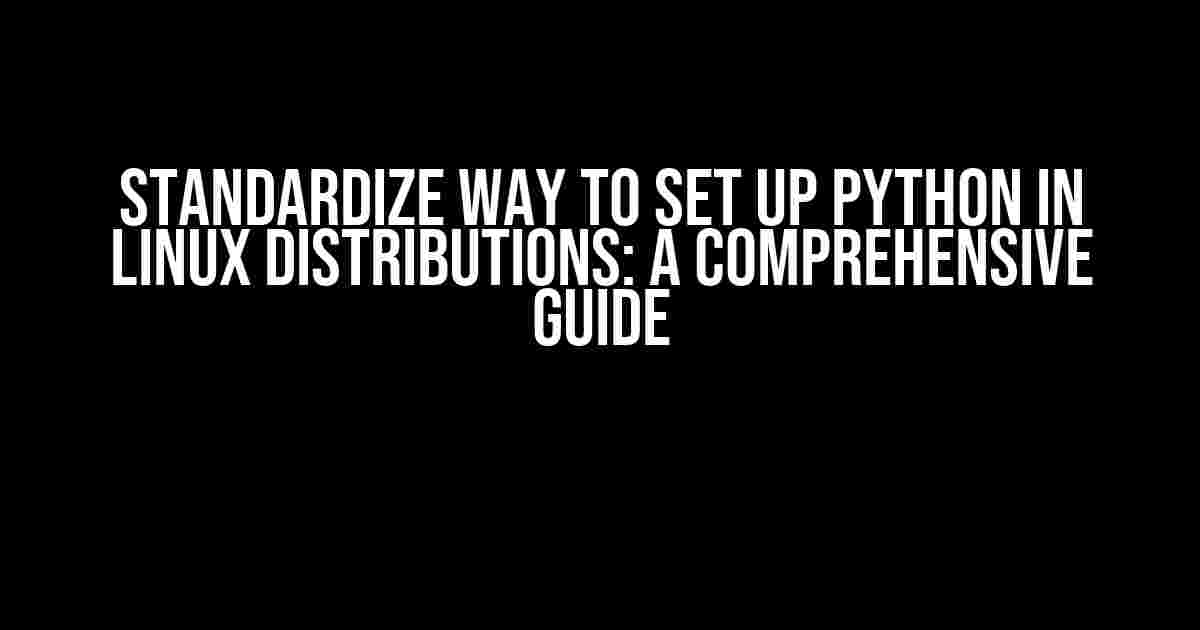Are you tired of struggling to set up Python on your Linux distribution? Do you wish there was a standardized way to get Python up and running, regardless of the distro you’re using? Look no further! In this article, we’ll take you through a step-by-step guide on how to standardize the way you set up Python in Linux distributions.
- Why Standardize Python Setup?
- Prerequisites
- Step 1: Update Your Package List
- Step 2: Install Python
- Step 3: Verify Python Installation
- Step 4: Install pip
- Step 5: Verify pip Installation
- Step 6: Install Essential Packages
- Step 7: Set up Your Python Environment
- Step 8: Install IDE or Text Editor
- Conclusion
- Troubleshooting Common Issues
- Best Practices
- Resources
Why Standardize Python Setup?
Having a standardized way to set up Python in Linux distributions is crucial for several reasons:
- Consistency**: A standardized setup ensures that you can easily switch between different Linux distributions without having to relearn how to set up Python.
- Efficiency**: With a standardized setup, you can quickly get started with Python development, without wasting time on configuring and troubleshooting.
- Repeatability**: A standardized setup makes it easy to reproduce your Python environment across different machines and environments.
Prerequisites
Before we dive into the setup process, make sure you have the following prerequisites:
- A Linux distribution installed on your machine (we’ll cover popular distros like Ubuntu, Debian, Fedora, and CentOS)
- A basic understanding of command-line interfaces and shell commands
- Access to the internet (for downloading packages and dependencies)
Step 1: Update Your Package List
The first step in setting up Python is to update your package list to ensure you have the latest packages and dependencies:
sudo apt update (for Ubuntu-based distros) sudo dnf update (for Fedora-based distros) sudo yum update (for CentOS-based distros)
Step 2: Install Python
Next, install Python using the package manager for your distribution:
sudo apt install python3 (for Ubuntu-based distros) sudo dnf install python3 (for Fedora-based distros) sudo yum install python3 (for CentOS-based distros)
Step 3: Verify Python Installation
Verify that Python has been installed correctly by running the following command:
python3 --version
This should display the version of Python installed on your system.
Step 4: Install pip
pip is the package installer for Python, and it’s essential for installing packages and dependencies. Install pip using the following command:
sudo apt install python3-pip (for Ubuntu-based distros) sudo dnf install python3-pip (for Fedora-based distros) sudo yum install python3-pip (for CentOS-based distros)
Step 5: Verify pip Installation
Verify that pip has been installed correctly by running the following command:
pip3 --version
This should display the version of pip installed on your system.
Step 6: Install Essential Packages
Install essential packages for Python development, such as:
sudo pip3 install virtualenv sudo pip3 install numpy sudo pip3 install pandas sudo pip3 install requests
Step 7: Set up Your Python Environment
Create a new virtual environment for your Python projects using virtualenv:
python3 -m virtualenv myenv
Activate the virtual environment:
source myenv/bin/activate
Verify that you’re now operating within the virtual environment:
python3 --version
This should display the version of Python within your virtual environment.
Step 8: Install IDE or Text Editor
Install an IDE or text editor of your choice, such as:
sudo apt install pycharm (for Ubuntu-based distros) sudo dnf install pycharm (for Fedora-based distros) sudo yum install pycharm (for CentOS-based distros)
Conclusion
And that’s it! You’ve successfully standardized the way you set up Python in Linux distributions. By following these steps, you can ensure that your Python environment is consistent across different Linux distributions and machines.
Troubleshooting Common Issues
If you encounter any issues during the setup process, refer to the following troubleshooting guide:
| Error Message | Solution |
|---|---|
| Python not found | Check if Python is installed correctly, and verify the path to the Python executable. |
| pip not found | Check if pip is installed correctly, and verify the path to the pip executable. |
| Package not found | Check if the package is available in the repository, and verify the package name. |
Best Practices
To ensure that your Python environment remains stable and efficient, follow these best practices:
- Regularly update your package list and Python packages.
- Use virtual environments to isolate your Python projects.
- Keep your Python environment clean by removing unnecessary packages.
- Use a consistent naming convention for your Python projects and files.
By following these steps and best practices, you’ll be well on your way to standardizing the way you set up Python in Linux distributions.
Resources
For more information on Python and Linux distributions, refer to the following resources:
We hope this comprehensive guide has helped you standardize the way you set up Python in Linux distributions. Happy coding!
Frequently Asked Question
Get ready to master the standard way to set up Python in Linux distributions and take your coding skills to the next level!
What is the best way to install Python on Linux distributions?
The most recommended way to install Python on Linux distributions is through the package manager specific to your distribution. For example, on Ubuntu or Debian, you can use `sudo apt-get install python3`, while on Red Hat or CentOS, you can use `sudo yum install python3`. This ensures that you get the latest version of Python and its dependencies.
How do I set up my Python environment on Linux?
To set up your Python environment on Linux, you can create a virtual environment using `python3 -m venv myenv` (replace `myenv` with your desired environment name). Then, activate the environment using `source myenv/bin/activate`. This will isolate your project’s dependencies and make it easy to manage different projects with different requirements.
What is the difference between Python 2 and Python 3, and which one should I use?
Python 2 and Python 3 are two major versions of the Python language. Python 2 is an older version that is no longer supported, while Python 3 is the latest and recommended version. Python 3 has many improvements and new features, and it’s the default version in most Linux distributions. Unless you have a specific reason to use Python 2, you should always use Python 3 for new projects.
How do I update my Python version on Linux?
To update your Python version on Linux, you can use the package manager specific to your distribution. For example, on Ubuntu or Debian, you can use `sudo apt-get update && sudo apt-get full-upgrade`, while on Red Hat or CentOS, you can use `sudo yum update`. This will update Python and its dependencies to the latest version available in the repositories.
What are some essential packages to install after setting up Python on Linux?
After setting up Python on Linux, some essential packages to install include `pip` (the Python package manager), `ipython` (an interactive shell for Python), `virtualenv` (for creating virtual environments), and `python3-dev` (for building and installing Python packages from source). You can install these packages using the package manager specific to your distribution.




